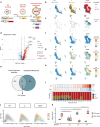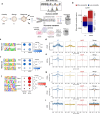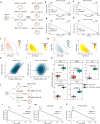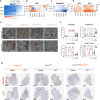Oncofetal reprogramming drives phenotypic plasticity in WNT-dependent colorectal cancer
- PMID: 39930084
- PMCID: PMC11821538
- DOI: 10.1038/s41588-024-02058-1
Oncofetal reprogramming drives phenotypic plasticity in WNT-dependent colorectal cancer
Abstract
Targeting cancer stem cells (CSCs) is crucial for effective cancer treatment, yet resistance mechanisms to LGR5+ CSC depletion in WNT-driven colorectal cancer (CRC) remain elusive. In the present study, we revealed that mutant intestinal stem cells (SCs) depart from their canonical identity, traversing a dynamic phenotypic spectrum. This enhanced plasticity is initiated by oncofetal (OnF) reprogramming, driven by YAP and AP-1, with subsequent AP-1 hyperactivation promoting lineage infidelity. The retinoid X receptor serves as a gatekeeper of OnF reprogramming and its deregulation after adenomatous polyposis coli (APC) loss of function establishes an OnF 'memory' sustained by YAP and AP-1. Notably, the clinical significance of OnF and LGR5+ states in isolation is constrained by their functional redundancy. Although the canonical LGR5+ state is sensitive to the FOLFIRI regimen, an active OnF program correlates with resistance, supporting its role in driving drug-tolerant states. Targeting this program in combination with the current standard of care is pivotal for achieving effective and durable CRC treatment.
© 2025. The Author(s).
Conflict of interest statement
Competing interests: E.G.’s laboratory received research funds from AZ and Prelude Therapeutics (for unrelated projects). E.G. is a cofounder and shareholder of Immunoa Pte. Ltd and cofounder shareholder, consultant and advisory board member of Prometeo Therapeutics. G.G. is inventor on the patent application no. EP18192715 by the MDC for the design and use of sLCRs. R.S. is cofounder and CEO of Panacent Bio, Inc. and equity holder in GeneDx, neither of which has contributed to or been involved in the research in this publication. The other authors declare no competing interests.
Figures












Update of
-
A Mutation-driven oncofetal regression fuels phenotypic plasticity in colorectal cancer.bioRxiv [Preprint]. 2023 Dec 10:2023.12.10.570854. doi: 10.1101/2023.12.10.570854. bioRxiv. 2023. Update in: Nat Genet. 2025 Feb;57(2):402-412. doi: 10.1038/s41588-024-02058-1. PMID: 38106050 Free PMC article. Updated. Preprint.
References
-
- Sinicrope, F. A. Increasing incidence of early-onset colorectal cancer. N. Engl. J. Med.386, 1547–1558 (2022). - PubMed
-
- Merlos-Suarez, A. et al. The intestinal stem cell signature identifies colorectal cancer stem cells and predicts disease relapse. Cell Stem Cell8, 511–524 (2011). - PubMed
-
- Ohta, Y. et al. Cell–matrix interface regulates dormancy in human colon cancer stem cells. Nature608, 784–794 (2022). - PubMed
MeSH terms
Substances
Grants and funding
LinkOut - more resources
Full Text Sources
Medical
Molecular Biology Databases

